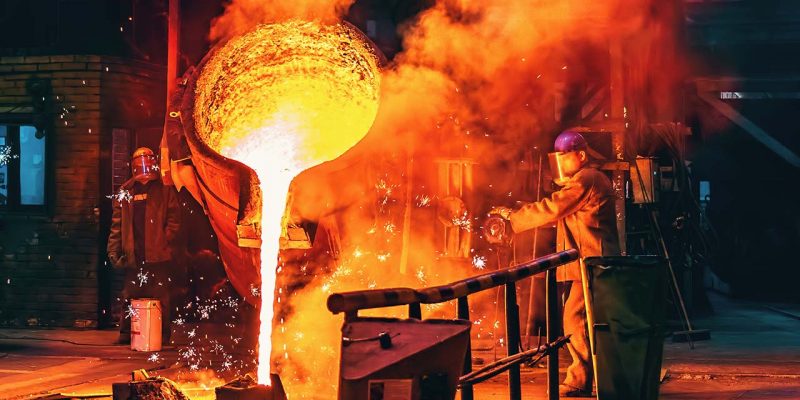While less visible than motor vehicles and power plants, steel manufacturing is a similarly significant source of global carbon emissions. That’s why the global steel industry is now under pressure to turn to “green steel” production to help combat the climate crisis.
Steel is the world’s most commonly used metal and is essential to modern society.1 It can be found in all aspects of our lives: cars and bridges, airplanes and cruise ships, refrigerators and microwaves.
The steel industry produces nearly 2 billion tons of steel each year, with every ton of steel equating to 1.85 tons of carbon dioxide released into the atmosphere. That’s good for about 8 percent of global carbon emissions.2
All steel is made from iron – and small amounts of carbon – which needs to be chemically altered in an industrial process and then refined.3 In traditional steel manufacturing, this process requires massive amounts of coal.
First, coal is heated to remove water and other chemicals, resulting in a near-pure form of carbon called coke.4 Then, in a coal-fired blast furnace that reaches temperatures of three thousand degrees, coke and iron ore are heated until a chemical reaction is triggered in which oxygen atoms loosen from iron atoms in the ore.5 This process is called reduction, and, along with CO2 by-products, it results in a crude, molten iron called pig iron, which is the basic ingredient used to produce steel.6
The pig iron, which has a carbon content that is too high for steel, then enters an additional furnace called a basic oxygen furnace, where it is blown with purified oxygen at high speeds.7 This process decreases the iron’s carbon content – while also creating carbon gas byproducts – until it becomes crude steel, which can then be further refined into higher-grade steel alloys.
Since coal – and the carbon emissions that come with its use – is instrumental in traditional steel production both as fuel for furnaces and as a reduction agent, it’s no surprise that many of the efforts to reduce the carbon emissions of steel manufacturing attempt to largely remove coal from the equation.
One of the leading efforts to do just that is taking place in Sweden. A project called HYBRIT (Hydrogen Breakthrough Ironmaking Technology) – a collaboration between SSAB, a steelmaker, LKAB, an iron-ore mining company, and Vattenfall, the state-owned electrical utility – is attempting to decarbonize the entire steel manufacturing process. Instead of coke, the process uses hydrogen gas as a reduction agent, resulting in “direct reduction” and producing only water as a byproduct. Since iron needs carbon to become steel, the “direct-reduced iron” is then passed into an electric arc furnace, a more energy-efficient furnace that melts the iron along with a small amount of coal to produce steel.8
Unfortunately, this doesn’t entirely solve steel’s carbon problem. Hydrogen typically comes from natural gas, and the process to extract it uses energy that is mostly derived from fossil fuels. Green hydrogen, on the other hand, is derived from water through a process called electrolysis. Yet, as with all other industrial processes, this too requires energy. A transition to truly green steel, produced using green hydrogen, would require an immense amount of renewable energy. Even then, direct emissions from iron mining and transportation would also have to be curbed.9
Despite these challenges, it is clear that steel manufacturing is headed in the direction of green steel. Seven out of the ten biggest steel-producing countries have invested in at least one green steel project, and the top five steel-producing companies have at least one project in the works.10
In addition to the HYBRIT project, other companies and startups are experimenting with radical, new technologies that may contribute to reducing steel’s carbon footprint. Austria’s SuSteel aims to reduce iron ore using hydrogen plasma while simultaneously adding just enough carbon to form crude steel, thus eliminating the need for eclectic arc furnace processing. In Boston, MIT spinout Boston Metal is developing a process called molten oxide electrolysis, which uses electricity to reduce iron ore to pure liquid iron suitable for refinement.11
Demand for steel will only continue to grow over the next several decades, with some estimating that it will nearly double by 2050. 12 While green steel manufacturing has a ways to go before it becomes scalable and cost-competitive, it’s clear that an industry-wide transition is needed to reduce the impact of one of our most vital – and carbon-intensive – materials.
Be sure to check out other advances in hydrogen production here.
- “‘Green steel’: The race to clean up one of the world’s dirtiest industries.” ↩︎
- “Decarbonization challenge for steel” ↩︎
- “How is Steel Made?” ↩︎
- “Coking Coal for steel production and alternatives” ↩︎
- “The Promise of Carbon Neutral Steel” ↩︎
- “Coking Coal for steel production and alternatives” ↩︎
- “Equilibrium and Kinetic Simulations of the Basic Oxygen Furnace Process” ↩︎
- “The Promise of Carbon Neutral Steel” ↩︎
- ““The Promise of Carbon Neutral Steel” ↩︎
- “Green steel production: How G7 countries can help change the global landscape” ↩︎
- “Can industry decarbonize steelmaking?” ↩︎
- “The Promise of Carbon Neutral Steel” ↩︎



















Comments